
Excursions in Physics
PHY
3050C
First Hour Exam
May 12, 2000
![]()
| Back to Excursion's Calendar |
![]()

Excursions in Physics
PHY
3050C
First Hour Exam
May 12, 2000
![]()
| Back to Excursion's Calendar |
![]()
For every question, also consider the following as a possible answer:
e) none of the above
Possibly useful information:
v =x /
t
a =v /
t
v = vi + a t
x = xi + vi t + (1/2) a t2
v = r
F = m a
F12 = &endash; F21
w = mg
g = 9.8 m/s2 Å 10 m/s2
C = 2 r; = 3.14
For every question, also consider the following as a possible
answer:
e) none of the above
1. Kinematics is a description of motion. Motion was first well
understood
a) by Henry Cavendish during the Industrial Revolution
b) by Aristotle and the ancient Greeks during the Golden Age
c) by Ptolemy in Egypt during the Ramses Dynasty
d) by Galileo in Italy during the Renaissance
2. Galileo was given a lifetime pension by the "city fathers" of
Venice because he introduced
a) the pendulum clock
b) the water clock
c) the telescope
d) the sun dial
3. Galileo took a position as a professor of mathematics and
taught
a) Euclid's geometry
b) Newton's differential calculus [ Newton was born the year Galileo died. ]
c) von Liebnitz' integral calculus [ von Liebnitz was a contemporary of Newton's. ]
d) Rubick's cubism [ Rubick's Cube is from the twentieth century. ]
4. Velocity is the time rate of change of
a) acceleration
b) speed
c) displacement
d) momentum
5. Acceleration is the time rate of change of
a) velocity
b) displacement
c) distance
d) momentum
6. Acceleration might be described as telling
a) where an object is located relative to an origin or reference point.
b) how fast something is moving.
c) how fast something is getting faster.
d) how long an object has been moving.
7. What is the average speed of a car that travels 125 km in 5 h?
a) 625 km/h
b) 25 km/hv = dist/timev = 125 km / 5 h
v = 25 km/h
c) 10 km/h
d) 9.8 km/h
8. Consider a train that has an acceleration of 3 m/s2.
Initially, at time t = 0, it has a velocity of vi = 20
m/s. What is its speed at t = 3 s?
a) 57 m/s
b) 41 m/s
c) 29 m/sv = vi + a tv = ( 20 m/s ) + ( 3 m/s2 ) ( 3 s )
v = 20 m/s + 9 m/s
v = 29 m/s
d) 9 m/s
9. Consider a car that starts at rest and accelerates at 2
m/s2 for 3 seconds.
At that time, t = 3 s, how fast is it
going?
a) 18 m/s
b) 12 m/s
c) 9 m/s
d) 6 m/sv = vi + a tv = ( 0 ) + ( 2 m/s2 ) ( 3 s )
v = 0 + 6 m/s
v = 6 m/s
10. Consider a car that starts at rest and accelerates at 3
m/s2 for 4 seconds. At
that time, t = 3 s, how far has
it gone?
a) 48 m
b) 24 mx = xi + vi t + (1/2) a t2x = 0 + 0 + (1/2) ( 3 m/s2 ) ( 4 s )2
x = (1/2) ( 3 ) ( 16 ) m
x = 24 m
c) 12 m
d) 6 mThat's the solution for t = 4 s. But what about t = 3 s? This question was (and is) confusing. So it was thrown out. Everyone got credit for this question.
11. Consider a ball that is thrown upward at the edge of a canyon
with an initial velocity of 20 m/s. Three seconds later, what is
its velocity?
a) 30 m/s
b) 15 m/s
c) - 10 m/sv = vi + a tv = ( 20 m/s ) + ( - 10 m/s2 ) ( 3 s )
v = ( 20 - 30 ) m/s
v = - 10 m/s
d) - 30 m/s
12. Consider a ball that is thrown straight upward at the edge of a
canyon with an initial velocity of 20 m/s. Three seconds later,
where is it located? Take its initial position, at the
edge of the canyon, to be the origin; that is, yi = 0.
a) 30 m
b) 15 my = yi + vyi t + (1/2) ay t2y = 0 + ( 20 m/s ) ( 3 s ) + (1/2) ( - 10 m/s2 ) ( 3 s )2
y = [ ( 20 ) ( 3 ) - (1/2) ( 10 ) ( 9 ) ] m
y = [ 60 - 45 ] m
y = 15 m
c) - 10 m
d) - 30 m
13. A rock climber dislodges a rock and notices that it falls for
6 seconds before hitting the canyon floor below. How
fast is it going when it strikes the canyon floor?
a) 10 m/s
b) 15 m/s
c) 30 m/s
d) 60 m/sv = vi + a tv = ( 0 ) + ( - 10 m/s2 ) ( 6 s )
v = - 60 m/s
The minus sign simply means it is moving DOWN.
14. A rock climber dislodges a rock and notices that it falls for
6 seconds before hitting the canyon floor below. How
far has it fallen when it strikes the canyon floor?
a) 10 m
b) 60 m
c) 180 my = yi + vyi t + (1/2) ay t2y = 0 + 0 + (1/2) ( - 10 m/s2 ) ( 6 s )2
y = [ - (1/2) ( 10 ) ( 36 ) ] m
y = - 180 m
Again, the minus sign simply means it is BELOW where it started.
d) 360 m
15. Consider a ball that is thrown horizontally from
the edge of a building with an initial velocity of 20 m/s. The
ball is thrown 5 m above the driveway below. How far
from the building does the ball strike the driveway?
a) 5 m
b) 10 m
c) 15 m
d) 20 m
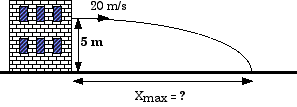
Before we can answer "How far?" we must first find out "How long?"y = yi + vyi t + (1/2) ay t20 = 5 m + 0 + (1/2) ( - 10 m/s2 ) ( t )2
0 = 5 m + 0 + ( - 5 m/s2 ) ( t )2
( 5 m/s2 ) ( t )2 = 5 m
( t )2 = 1 s2
t = 1 s
The ball is in the air for one second. How far does it travel horizontally in that time?
x = xi + vx tx = 0 + ( 20 m/s ) ( 1 s )
x = 20 m
16. Projectile motion is a combination of
a) horizontal motion with constant, non-zero acceleration and vertical motion with constant veloci
b) horizontal motion with constant non-zero acceleration and vertical motion with constant, non-zero acceleration
c) horizontal motion with constant velocity and vertical motion with constant, non-zero acceleration.
d) horizontal motion with constant velocity and vertical motion with constant velocity
17. Consider a ball thrown from a level surface with an initial
upward velocity of 20 m/s and an initial horizontal velocity of
7 m/s. How long is the ball in the
air?
a) 1.0 s
b) 2.0 s
c) 4.0 sy = yi + vyi t + (1/2) ay t20 = 0 + ( 20 m/s ) t + (1/2) ( - 10 m/s2 ) ( t )2
0 = 0 + 20 t - 5 t2
5 t2 - 20 t = 0
( 5 t ) ( t - 4 ) = 0
Either
5 t = 0t = 0
While this is true, t = 0 is not very "interesting".
or
t - 4 = 0t = 4 s
We could also have arrived at this time of t = 4 s just by looking at the velocity at the end of every second.
For t = 0, v = 20 m/sfor t = 1 s, v = 10 m/s
for t = 2 s, v = 0
for t = 3 s, v = - 10 m/s
for t = 4 s, v = - 20 m/s
When the speed is the same (20 m/s), the ball is back at its starting place.
Either way, we know the ball takes four seconds to get back to its initial position, the level surface from which it was thrown.
d) 8.0 s
18. Consider a ball thrown from a level surface with an initial
upward velocity of 10 m/s and an initial horizontal velocity of 7
m/s. Where does it land? That is, measured from its
initial position, where does it come back to and strike the level
surface?
a) 7 m
b) 14 m
c) 28 m
d) 56 m
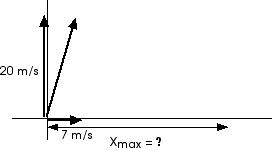
From the previous question we know the ball will be in the air for four seconds. How far does it move -- that is, how far, horizontally, does it move -- during that time?x = xi + vx tRemember, ax = 0; there is no horizontal acceleration.
x = xi + vx tx = 0 + (7 m/s)(4 s)
x = 28 s
19. Consider two children on a playground merry-go-round. One is near the center and one is near the edge. The child near the edge
a) requires more time to make one revolution than
b) travels slower than
c) requires less time to make one revolution than
d) makes one revolution in the same time as
the child near the center.
20. If a Ferris wheel has a radius of 10 m and requires 20 seconds to make a
revolution, what is the linear speed of a passenger? C = 2
![]() r;
r; ![]() = 3.14
= 3.14
a) 0.78 m/s
b) 1.57 m/s
c) 3.14 m/s
d) 9.80 m/sDue to the typo, this questions was not counted. Everyone got credit for this question.
The 2 in C = 2
r was missing in the printed, hard-copy version of this exam.
Solution:
v = dist / timev = C / time
v = 2
r / 20 s
v = [ (2)(3.14)(10) / 20 ] [m/s]
v = 3.14 m/s
21. Newton's First Law of Motion states that, in the absence
of a net force, an object in motion will
a) eventually come to rest
b) continue in motion but slow down until it stops
c) continue in motion with the same speed along the same straight line
d) continue along the same straight line with a decrease in speed
22. Newton's Second Law of Motion explains the cause of motion
and may be stated as
a) "All motion is relative."
b) "All objects fall with the same velocity."
c) "The acceleration of an object is proportional to the net force on the object and inversley proportional to the object's mass."a = F / mF = ma
d) "The acceleration of an object is proportional to the product of the object's mass and the net force on it."
23. Newton's Second Law of Motion explains the cause of motion
and may be stated as
a) The net force on an object is inversely proportional to its weight.
b) The net force on an object produces an acceleration that is proportional to the time of action of that force.
c) The net force on an object is equal to the product of the mass of that object and its acceleration.F = mad) The net force on an object is inversely proportional to the mass of the object.
24. Mass is a measure of
a) the volume of an object
b) the size of an object
c) how difficult it is to change the motion of an object
d) the velocity of an object
25. The weight of an object is
a) the same thing as the mass of an object
b) the sum of all the forces on an object
c) the force of gravity on an object
d) always less than the mass, even in a vacuum
26. The net force on a 10-kg object, at rest, is
a) 98 N
b) 49 N
c) 10 N
d) zeroThe net force on any object at rest is zero!
27. The net force on a 10-kg object, in free fall,
is
a) 98 Nw = m gw = (10 kg)(9.8 m/s2)
w = 98 N
b) 49 N
c) 10 N
d) zero
28. Harry the Painter has a weight of 500 N. When he is suspended as
shown in the sketch here, what is the tension in the rope?
a) 1000 N
b) 500 N
c) 250 N
d) 25 N
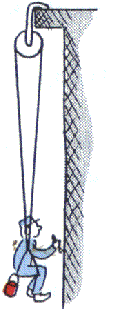
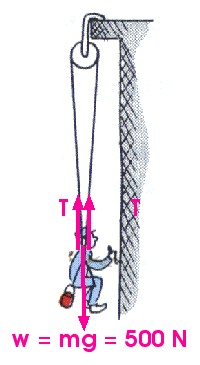
29. A force of 24 N acts on an object whose mass is 8 kg. This causes
the object to accelerate at
a) 2 m/s2
b) 3 m/s2F = m a24 N = ( 8 kg ) ( a )
24 N = ( 8 kg ) ( 3 m/s2 )
a = 3 m/s2
c) 6 m/s2
d) 12 m/s2
30. A car, with mass of 1,000 kg, accelerates at 3
m/s2.
The net force exerted on the car must be
a) 333 N
b) 1,000 N
c) 2,000 N
d) 3,000 NF = m aF = ( 1000 kg ) ( 3 m/s2 )
31. The weight of a 1,000-kg car is
a) 500 N
b) 1,000 N
c) 2,000 N
d) 10,000 Nw = m gw = (1,000 kg)(10 m/s2)
w = 10,000 N
32. What is the mass of a fireman whose
weight is 500 N?
a) 9.8 kg
b) 25 kg
c) 50 kg
d) 500 kgw = m g500 N = m ( 10 m/s2 )
500 N = ( 50 kg ) ( 10 m/s2 )
m = 50 kg
33. A fireman, whose weight is 500 N, slides down a
pole with an acceleration of 2 m/s2. The forces that act
on him are his weight pulling him down and the force of friction
pulling up on him to slow him down. The force of
friction must be
a) 50 N
b) 100 N
c) 400 NF = m aFnet = m a
Fnet = ( 50 kg) ( 2 m/s2 )
Fnet = 100 N
Fnet = w - Ffriction
Fnet = 500 N - Ffriction
100 N = 500 N - Ffriction
Ffriction = 400 N
d) 500 N
34. Suppose you are driving along in an open car and throw a ball
straight up into the air. While the ball is still in the air you
step on the brakes. Where does the ball land relative
to the car?
a) behind the car
b) back into the car
c) in front of the carThe ball continues on with the same horizontal velocity. It continues on and lands where the car would have been if you had not stepped on the brakes. But the car has slowed down so the ball ends up in front of the car.
35. If a sailor drops a wrench from the top of a tall mast on a
moving ship, it will fall and hit the deck
a) in front of the base of the mast.
b) at the base of the mast.Think back to my demonstration and to the movies from "The Mechanical Universe".c) behind the base of the mast.
36. Sir Isaac Newton
a) first discovered the Law of Falling Bodies while at the University of Pisa.
b) was a close friend of Liebnitz and encouraged his early development of calculus.
c) made great advances in Mechanics, Gravity, Optics, and Mathematics.
d) used water clocks of his own invention to aid sailors in determining their longitude.
37. Galileo
a) may be called the Father of Modern Optics.
b) wrote his findings in Polish while at the University of Paduah.
c) may be called the Father of Modern Science.
d) wrote his findings about Gravity and explained calculus.
38. The hallmark of Modern Science is that
a) theories are accepted or rejected based upon the background or reputation of the scientists who propose them.
b) predictions of theories must be tested by and agree with experimental results.
c) theories must have elegant mathematical equations.
d) predictions of theories must not contradict established authorities (such as Plato or Pythagores).
39. When applying Newton's Second Law of Motion, F = ma,
a) F is always the largest force present.
b) F is always the net force -- or the sum of all the forces present.
c) m is always the largest mass in the system.
d) m must be the smallest mass in the system.
40. What value will the spring scale read in the system shown
here?
a) zero
b) 50 N
c) 100 N
d) 200 N
41. In the sketch here, what value will the scale read if the little
girl's weight is 250 newtons.
a) zero
b) 125 N
c) 250 N
d) 500 N

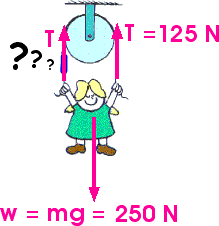
42. The four fundamental forces are
a) gravity, friction, electricity, and atomic
b) gravity, electromagnetic, strong nuclear, and weak nuclear
c) gravity, strong electric, weak electric, and atomic
d) gravity, friction, air resistance, and atomic
43. To measure the time intervals needed to investigate motion,
a) Aristotle used the pendulum clock which had just been invented
b) Ptolemy used a sundialc) Galileo invented his own water clocks
d) Newton invented the pendulum clock
44. What is the average speed of a motorcycle that travels 60 m in 4
s?
a) 30 m/s
b) 15 m/s
c) 10 m/s
d) 9.8 m/s
45. What is the average speed of a car that travels 75 km in 3 h?
a) 25 km/h
b) 15 km/h
c) 10 km/h
d) 9.8 km/h
46. Consider a ball that is thrown upward at the edge of a building
with an initial velocity of 30 m/s. Three seconds later, what is
its velocity?
a) 30 m/s
b) 15 m/s
c) zero
d) - 20 m/s
47. Consider a ball that is thrown straight upward at the edge of a
building with an initial velocity of 30 m/s. Three seconds later,
where is it located? Take
its initial position, at the edge of the building, to be the origin;
that is, yi = 0.
a) 60 m
b) 45 my = yi + vyi t + (1/2) ay t2y = 0 + (30 m/s) (3 s) + (1/2) ( - 10 m/s) (3 s)2
y = 0 + 90 m - 45 m
y = 45 m
c) 30 m
d) - 25 m
48. A rock climber dislodges a rock and notices that it falls for
4 seconds before hitting the
canyon floor below. How fast is it going when it
strikes the canyon floor? (What is its speed?)
a) 10 m/s
b) 15 m/s
c) 20 m/s
d) 40 m/s
49. A rock climber dislodges a rock and notices that it falls for 4 seconds before hitting the canyon floor below. How far has it fallen when it strikes the canyon floor?
a) 20 m
b) 40 m
c) 80 my = yi + vyi t + (1/2) ay t2y = 0 + 0 + (1/2) ( - 10 m/s) (4 s)2
y = 0 + 0 + (1/2) ( - 10 m/s) (16s2 )
y = - 80 m
d) 160 m
50. A force of 48 N acts on an object whose mass is 8 kg. This causes
the object to accelerate at
a) 2 m/s2
b) 3 m/s2F = m a48 N = ( 8 kg ) ( a )
48 N = ( 8 kg ) ( 3 m/s2)
a = 3 m/s2
c) 6 m/s2
d) 12 m/s2
| Back to Excursion's Calendar |
![]()
(C) 2003; Doug Davis; All rights reserved.